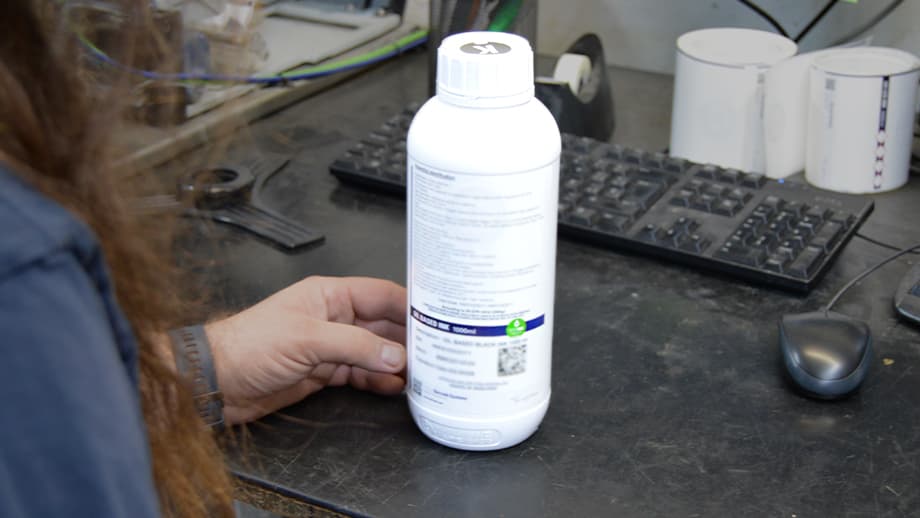In a world where environmental awareness becomes increasingly crucial, environmentally friendly inks take on significant importance. They are essential to ensure the proper treatment of the materials they are applied to or printed on. At United Barcode Systems, we have environmentally friendly inks for direct printing on corrugated cardboard. For this reason, in this article, we aim to explain the differences and the various uses of all types of eco-friendly inks.
What is an eco-friendly ink?

A bottle of environmentally friendly ink manufactured at UBS.
A eco-friendly ink is a type of ink used in various printing processes that is formulated and manufactured with ingredients and components that have a reduced environmental impact compared to conventional inks. These inks are designed to minimize their environmental footprint at all stages of their life cycle, from manufacturing to final disposal.
The reasons why companies prefer this type of ink are:
-
Sustainable Ingredients:
Eco-friendly inks use renewable and sustainable ingredients in their formulation. This may include water-based solvents, natural pigments derived from vegetable sources, vegetable oils and other biodegradable organic materials.
-
Reduced Toxic Components:
Unlike conventional inks, which can contain a variety of chemicals that are toxic and harmful to human health and the environment, eco-friendly inks are formulated to minimize or eliminate the presence of these hazardous components.
-
Lower VOC Emissions:
Eco-friendly inks are designed to have lower emission of volatile organic compounds (VOCs), which are chemicals that can easily evaporate at room temperature and contribute to air pollution. The reduction of VOCs in eco-friendly inks improves indoor air quality and reduces negative environmental impact.
-
Biodegradability and Recyclability:
Eco-friendly inks are designed to be biodegradable or recyclable, making them easier to dispose of and reducing their impact on landfills and the environment in general. This promotes more sustainable and responsible printing practices.
-
Performance and Quality:
Although eco-friendly inks are designed to be more environmentally friendly, they do not compromise on print quality. These inks can deliver high-quality results, with vibrant colors and good adhesion to a variety of substrates, making them suitable for a wide range of printing applications.
Eco-friendly inks have become the most popular choice in the industry because they minimize your environmental impact and promote more sustainable and responsible printing practices. These inks seek to reduce their environmental footprint and adopt more environmentally friendly printing practices, making them an attractive option for both businesses and environmentally conscious consumers.

UBS Eco-Friendly Inks
- Unique "Oil Based" formula free of mineral oils.
- No volatile organic compounds or odor.
- Optimized viscosity and surface tension stability.
What are vegetable-based inks and are they suitable for printing?
Vegetable inks are used in various printing processes that are mainly composed of pigments derived from vegetable sources. These pigments are obtained from materials such as fruits, vegetables, flowers, herbs and other plant resources.
The manufacture of vegetable inks involves extracting the pigments from plants and then combining them with other ingredients to form the ink. These natural pigments can provide a wide range of colors and shades, and their use dates back centuries in the history of printing, especially in applications such as craft printing, textile printing and food printing.
It is important to note that vegetable-based inks require certain adjustments in terms of stability, water resistance and other performance aspects compared to conventional inks. In addition, their use may be more limited in applications where greater durability or resistance to extreme environmental factors is required.
Would you like to stay up to date with the latest news in the packaging industry? Discover our newsletter!
Comparison of standard eco ink vs. UBS eco ink
At United Barcode Systems we take care of manufacturing every bottle of environmentally friendly ink used in our High-Resolution Inkjet printers. That is why we have compared it with a standard ink on the market designed for Inkjet printers and this is the result:
|
Feature |
Standard Eco Ink |
UBS Eco Ink |
| Regulatory compliance | Varies by manufacturer, although in this case it was not compliant with all regulations❌ | Complies with EuPIA, REACH, CLP, and suizas️ regulations✔️ |
| Volatile Organic Compounds (VOC). Easily converted to vapors or gases. | May be present❌ | No VOC (Volatile Organic Compounds) ✔️ |
| Non Volatile Compounds (NVC). Toxic and possible cause of respiratory damage. | Unknown➖ | No NVC ✔️ |
| Pyrrolidones. Cyclic resin that may cause cancer. | May be present➖ | No Pyrrolidones✔️ |
| Animal ingredients | May contain❌ | No glycerins or dispersants of animal origin✔️ |
| Parameter stability | Varies by manufacturer, in this case it is unknown➖ | Optimized for viscosity and surface tension✔️ |
| Colorimetry. Print quality. | Variable quality, although this one offered good print quality ✔️ | Maximum contrast in colorimetry ✔️ |
| Odor | May be perceptible➖ | No odor ✔️ |
| Recycling compatibility | Not guaranteed❌ | Meets FEFCO requirements for corrugated recycling✔️ |

